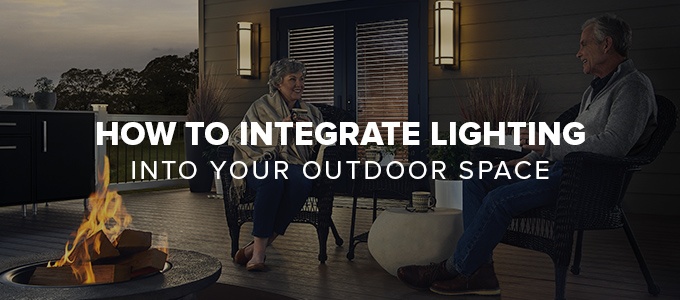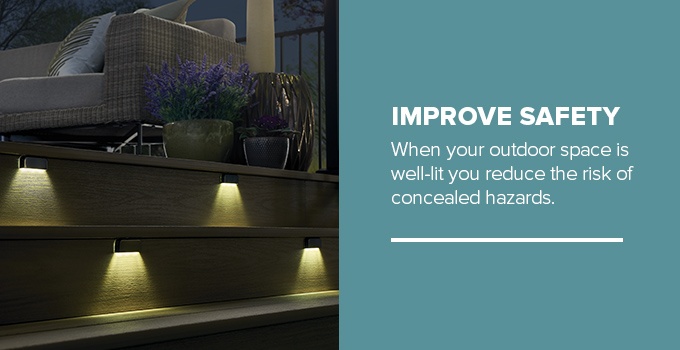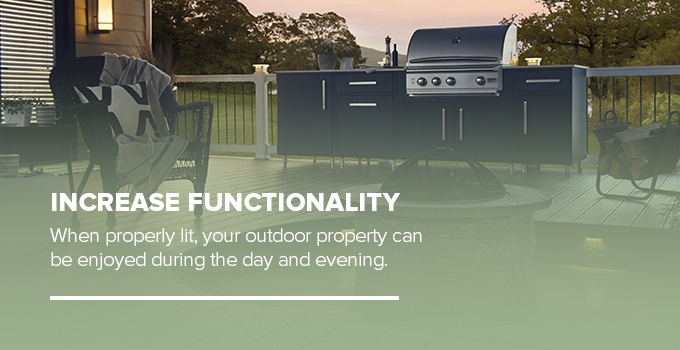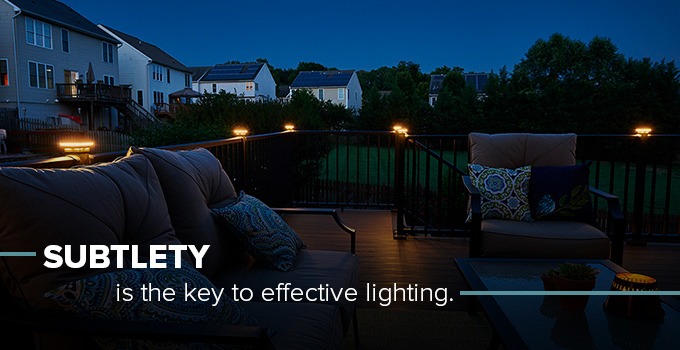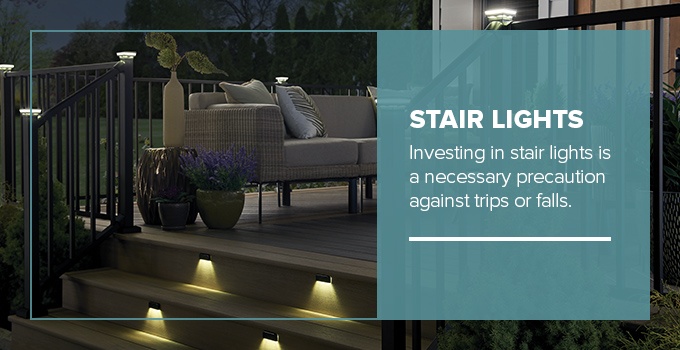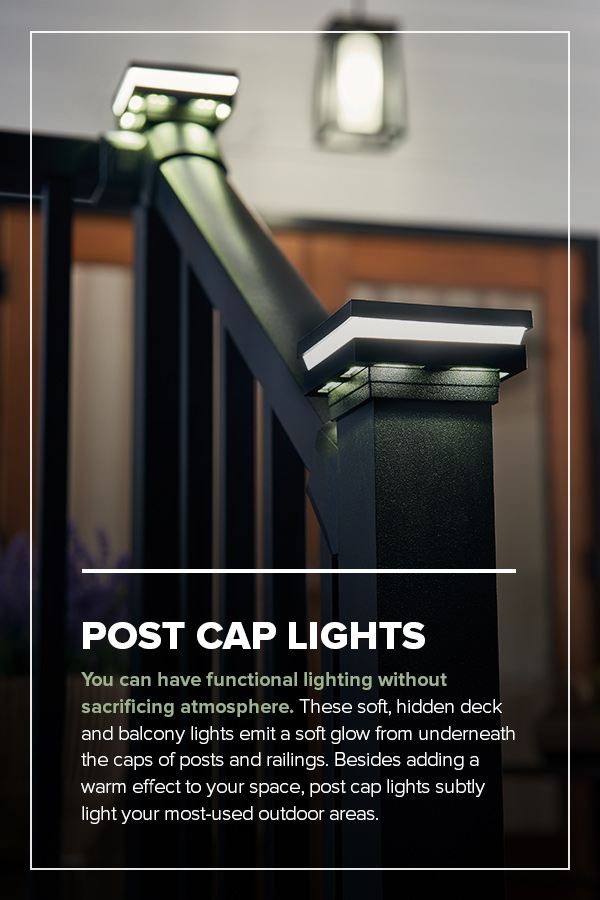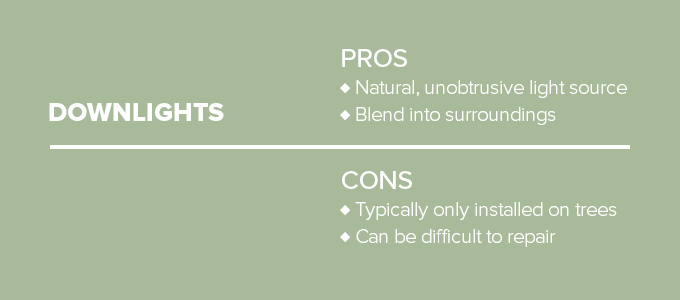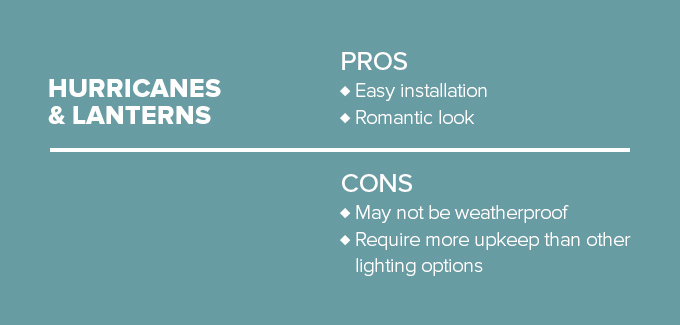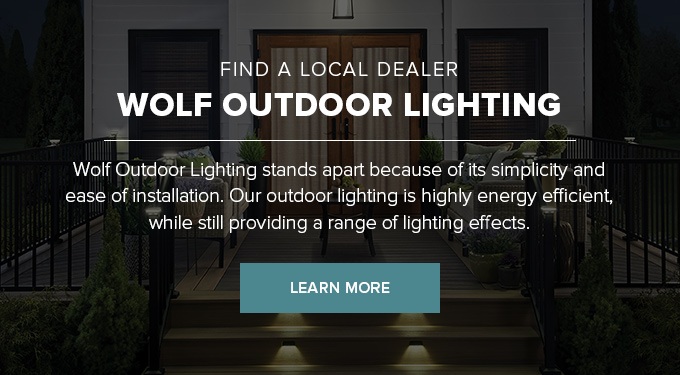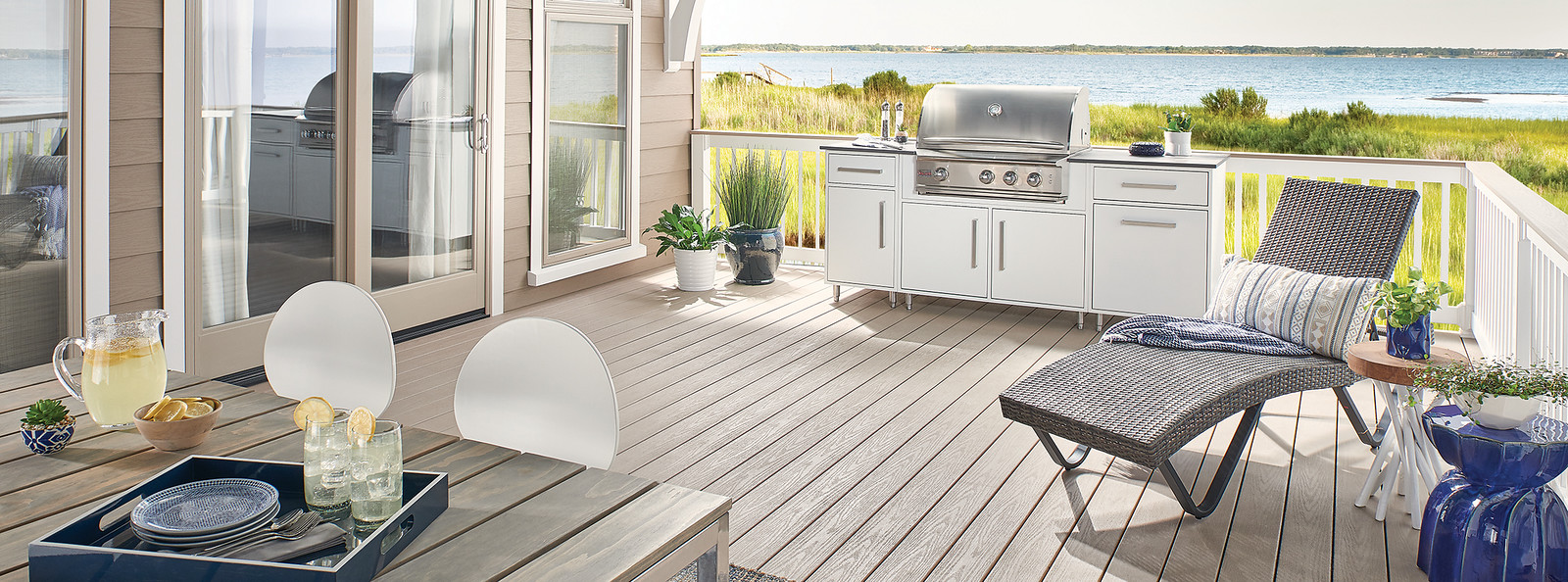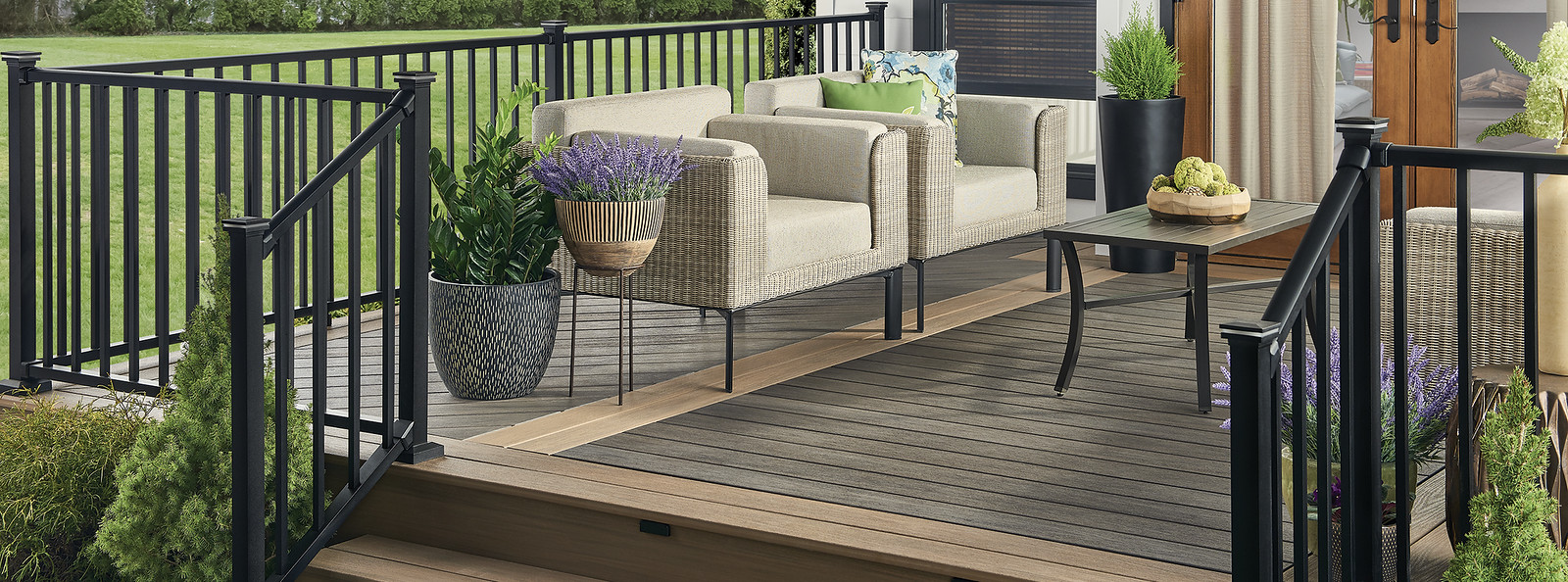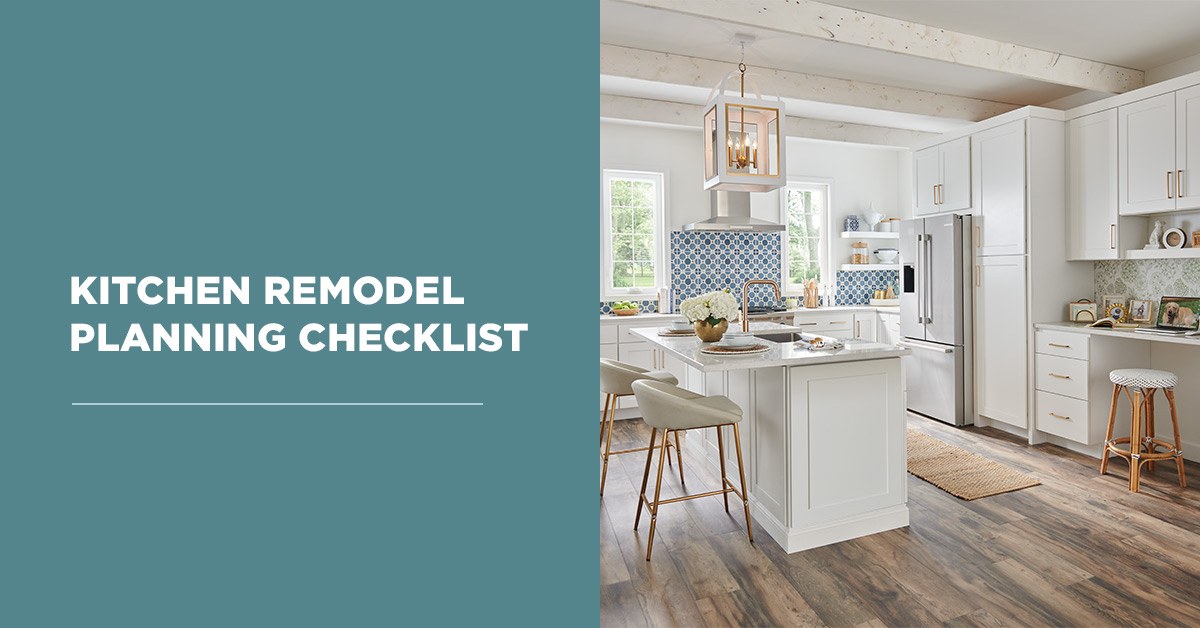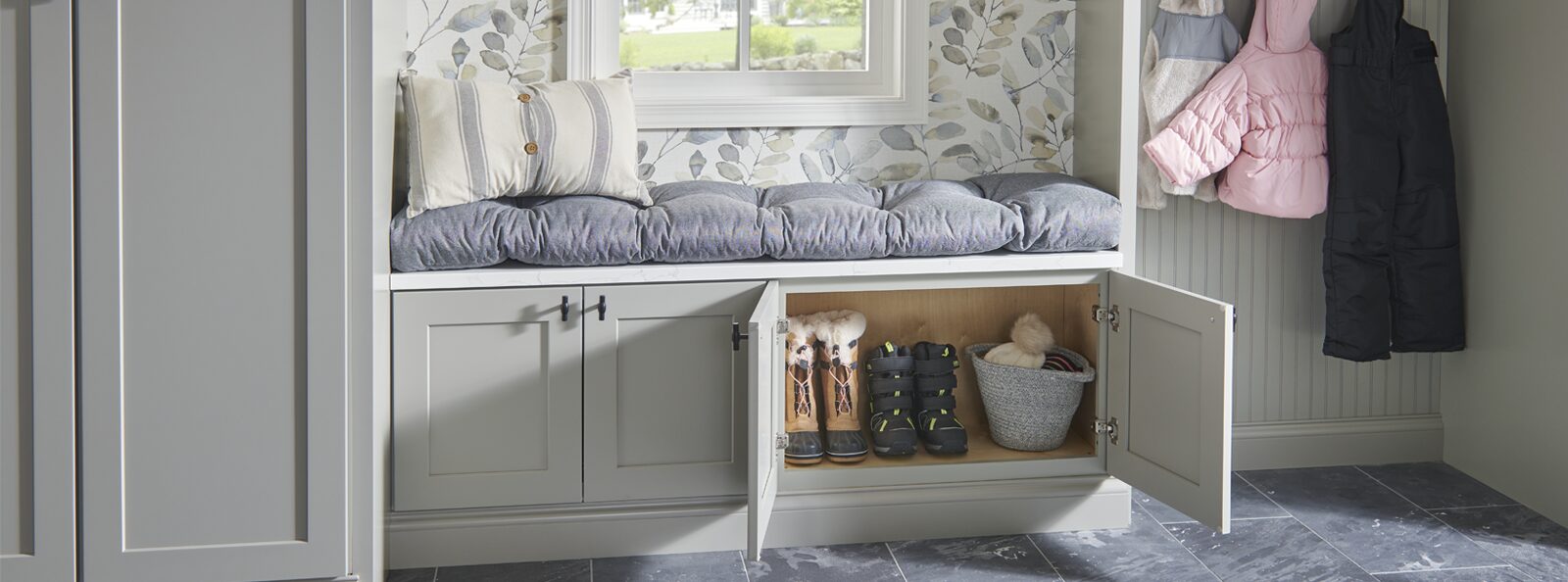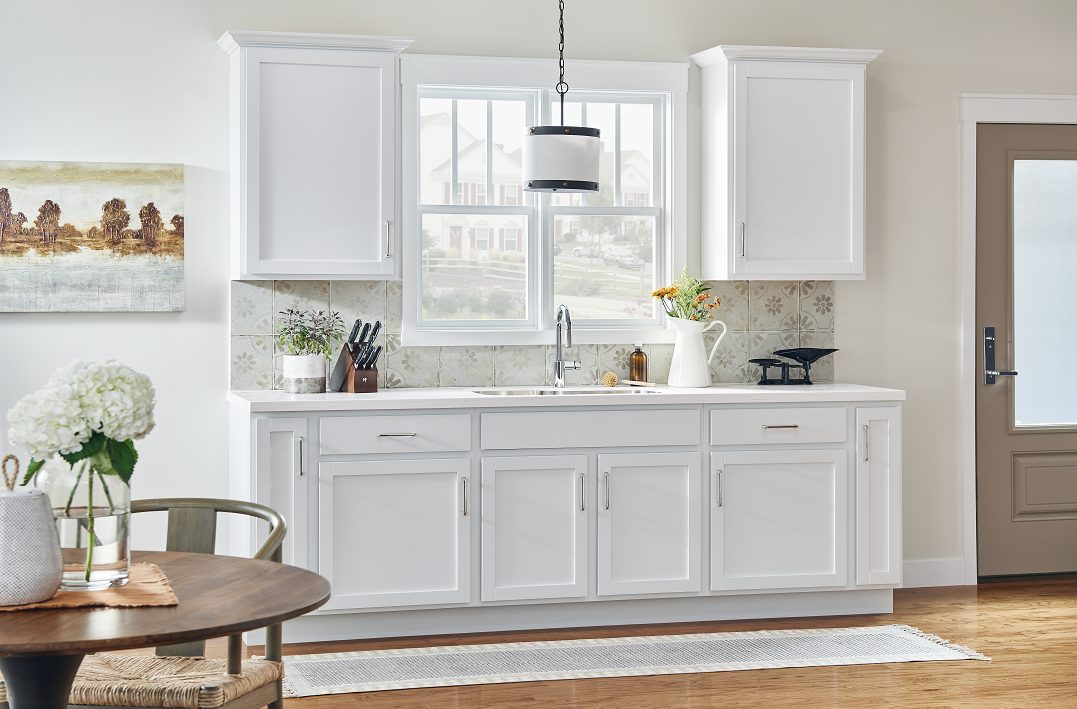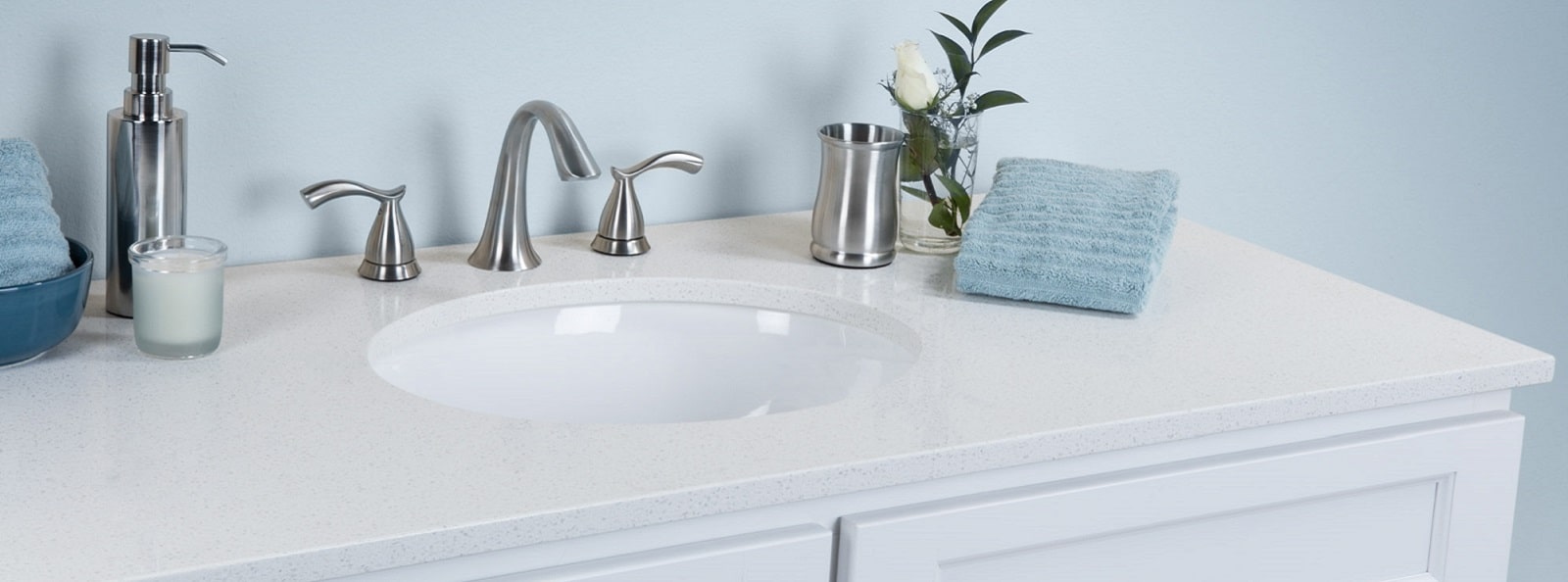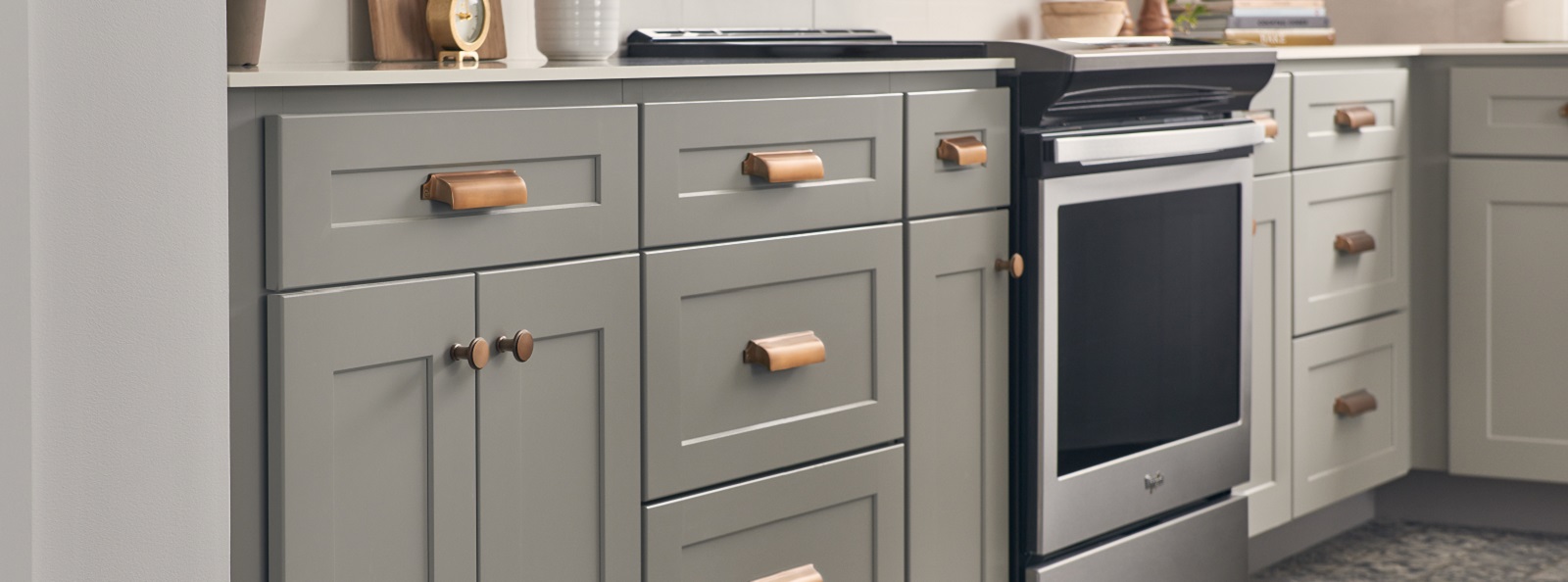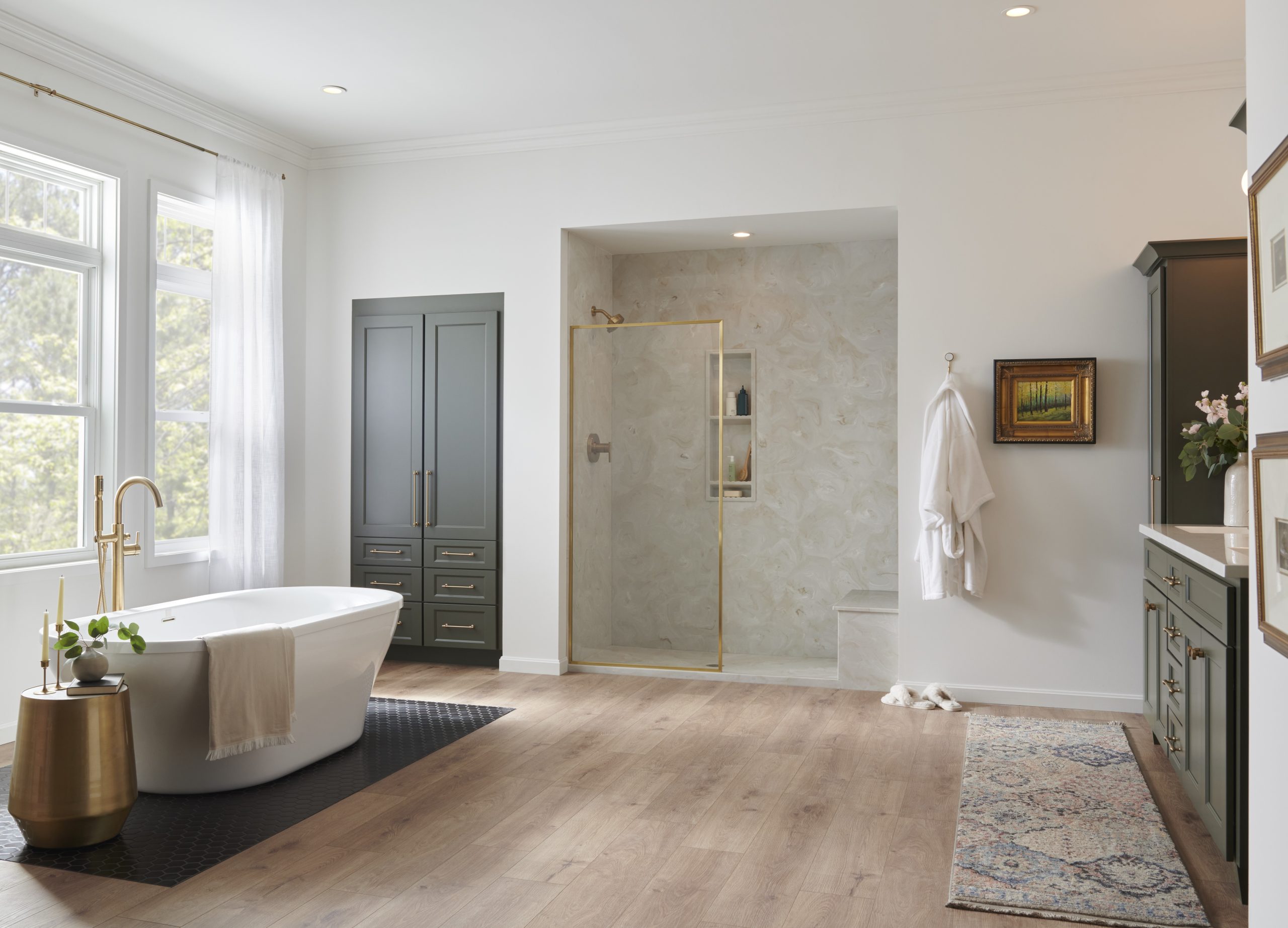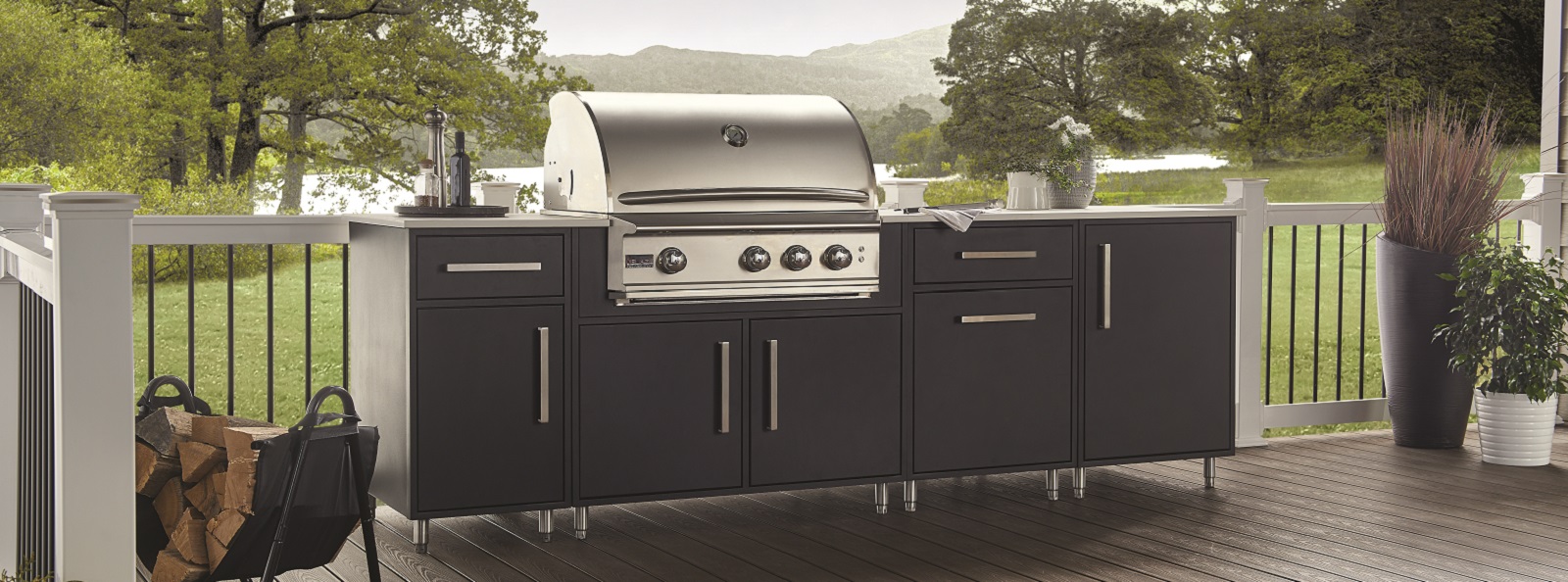
HOW TO INTEGRATE LIGHTING INTO YOUR OUTDOOR SPACE
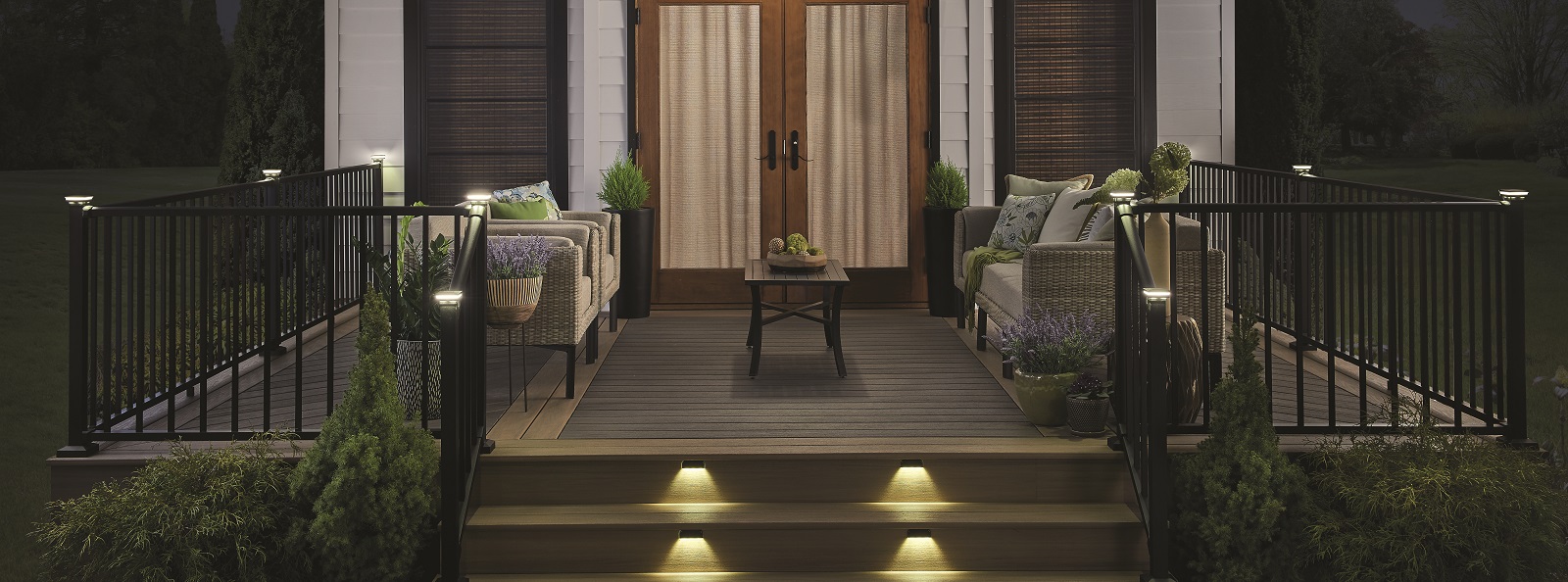
Summer is the season of warm weather, fireflies and barbeques. Summer months are for enjoying the outdoors, whether that’s a day at the lake or an evening on your deck.
But after the sun sets, your backyard goes dark. Everyone wanders inside, and your stunning, hard-worked-for deck sits unused.
Insufficient outdoor lighting limits an otherwise lovely space. You’ve invested too much into your property to let it sit untouched for half of the day.
Done well, outdoor lighting adds charm, functionality and security to your property. Soft cap lights add ambiance to an evening party, and elegant string lights set the mood for a romantic dinner. Good lighting transforms your deck, patio, or yard into an attractive destination for warm summer evenings.
But it’s easy to make mistakes. We all recognize under-lit properties — they’re full of unused patios, shadowy doorways and too-dark-to-walk paths. We also know the over-lit ones, which resemble crime scenes more than a well-designed yard.
With just a little preparation and planning, you can upgrade your daylight deck into an after-dark sanctuary. We’ve compiled this guide to help you transform your space into an inviting dusk-to-dawn destination.
WHY IT MATTERS
Although it contributes to an elegant atmosphere, outdoor lighting also provides functional benefits. Strategic lighting offers many advantages for your property, far beyond the aesthetic.
1. IMPROVE SAFETY
Your outdoor space is more than an extension of your house — it’s an extension of your home. In warm months, a lot of life is lived outside, especially in evenings when the temperature is a bit cooler. Over the summer, your yard will more than likely see a lot of foot traffic.
But a dark property is a recipe for accidents, for both yourself and your guests. Whether it’s children playing tag or adults climbing stairs, the potential for injury is everywhere. Without adequate lighting, you magnify the hazards of an ordinarily safe space.
Besides adding charm, under-rail or stair lights fill a vital function — allowing your guests to clearly see the boundaries and walkways of a space and hopefully enjoy their time outside without trips or falls.
2. DETER CRIME
When you leave for a vacation, conventional wisdom says to keep a few lights on to discourage potential break-ins. The same principle applies to your property — a well-lit space is a deterrent to night crime.
Outdoor lighting makes your property look lived-in and regularly enjoyed. Good lights reduce the chances of your home becoming a target and also increases visibility — with an illuminated space, you can see any trespassers long before they become a threat.
3. INCREASE FUNCTIONALITY
It’s a warm, breezy day, and you’ve invited some good friends over for dinner and a card game. But before it’s finished, the sun sets, and you have to leave your deck and move the party inside.
Without light, your outdoor property can only be enjoyed during the day. This not only reduces its use, but it lessens the return on your investment.
You have probably sacrificed many hours — and paychecks — into making your outdoor space an enjoyable location. By keeping it dark, you rob yourself of a valuable property asset and hamstring an otherwise thoroughly useful area of your home.
By investing in outdoor lighting, you invest in years of game nights — and add to the usability and enjoyment of your space.
4. CREATE ATMOSPHERE
During the day, everything in your yard is on display. Maybe you have a shed that desperately needs to be organized, or an old hickory tree dying in the back. But once it gets dark, you can direct attention to the beauty of the property, while minimizing what isn’t yet finished.
Add soft garden lights to reveal your lush landscaping or install well lights along a stone path. A well-placed wash light can subtly showcase your home’s architectural features without seeming flashy. Cap lights give sophistication to an otherwise plain deck, and under-rail lights draw pleasing contours around your space.
After dark, you can shape your property into whatever you like. Warm, soft lights create charming ambiance and highlight the best elements of your space.
BEFORE YOU BEGIN
Nothing makes a space more inviting than good lighting. But before you jump into installation, take the time to consider these important questions:
1. WHAT DO YOU WANT TO EMPHASIZE?
Every property has different features and attractions. Before installing an outdoor lighting system, determine your yard’s strengths.
If your property centers around your beautiful home, you might choose wash or bullet lights to emphasize structural elements. Maybe your landscape is stunning — place garden or solar lights to make paths accessible and enjoyable, even at night. If the crown of your backyard is an ancient, twisting oak, choose downlights to subtly accentuate its branch structure.
Also consider what you want to de-emphasize — a back drainage ditch, a newly planted hedge, an old shed that’s more of a lean-to. Instead, draw attention to your new deck or patio, or your arbor overflowing with jasmine.
When deciding what you want to accent, also consider backlight. To subtly showcase your fountain, you don’t necessarily need to shine a bullet light directly on it. Try placing the light source between the object and a tall structure like a wall. The light will reflect off of the flat surface and create a soft halo around the fountain, drawing attention without being obvious.
2. HOW BIG IS YOUR SPACE?
One of the most important factors to consider before purchasing lights is the size of your space. Are you working with a small patio or a five-acre yard?
The size of your property will determine more than just your budget. Even if you have unlimited funds, if you have a small, urban yard, flooding it with outdoor lights will overwhelm the space.
Subtlety is the key to effective lighting. Don’t be overwhelmed if your space is enormous — begin with the areas close to your home, and strategically string lights along frequented walkways. For a small backyard, try to limit yourself to one accent light, and a few supporting ambient lights.
3. WHAT IS A GOOD BUDGET?
Before beginning any project, you have to consider the size of your budget. Today, you can find a variety of low-voltage and cost-effective lighting options. But, like any investment, you’ll have to balance affordability with quality: new systems can start anywhere from $500-$2000, but quickly get more expensive the larger and more extensive they become.
Especially when dealing with electrical additions, the cheapest option is not always the best. If you choose models with inexpensive, low-quality casings, they might melt or corrode with the weather. The last thing you want is a fire or other electrical disaster to destroy the space you’ve worked so hard to create.
By establishing a solid budget, you know your parameters, and also where you can afford to splurge. Can you invest in modern-looking stake lights or Edison bulb string lights? What about professional help — can you afford to hire an expert, or should you find DIY-friendly options?
4. WILL YOU NEED TO HIRE A PROFESSIONAL?
With DIY-appropriate lights and Internet tutorials, you could transform your yard into an evening destination over a weekend. However, as with any electrical project, lighting can quickly get complicated.
For landscape lighting, set up is not as simple as running a long extension cord from your house. Typically, you’ll need a transformer to convert your home energy into a safer voltage, and some fixtures require cables buried underneath the ground.
For the most sophisticated and stunning effects, you will want to hire a landscape lighting specialist. Not only will an expert know the electrical details of installing lighting, but they will also have experience designing an outdoor space. A professional can help you take your backyard from tiki-torch practicality to cocktail-party elegance.
TYPES OF OUTDOOR LIGHTING
You’ve figured out the needs of your space, and now you’re ready to choose lights. There are almost endless options, though, and it’s easy to get lost in the possibilities. Below, we’ve grouped the most common types of outdoor lights into three broad categories: task, accent and ambient lights.
TASK LIGHTING
Task lights are designed for functionality. These are the essential elements of your space—before considering the ambiance of your property, you must consider the usability and safety of your yard.
But functionality doesn’t have to come at the expense of good, elegant design. Consider these task lights that are as stylish as they are useful.
While any light can technically be used for task lighting, below are some of the most common options for functionally lighting your property:
1. STAKE PATH LIGHTS
Easy to install and maintain, stake path lights are a popular choice for many homeowners. They can be powered by cables or solar panels, and cast light downward to illuminate the ground without blinding guests.
Because of their placement, stake lights are on display, which means you might want to consider aesthetic design as well as affordability.
Stagger on opposite sides of a path for a balanced, pleasing glow.
Pros:
- Easy to install
- Affordable options
Cons:
- Can impede lawn care
- Must consider aesthetic design
2. STAIR LIGHTS
Poorly-lit stairs are a looming safety hazard. Especially if you have old, historic stairs with worn tread or uneven step heights, investing in stair lights is a necessary precaution against trips or falls — some building codes even require outdoor stairs to be lit.
Stair lights don’t have to be purely functional, though. Try subtle, understated designs to softly illuminate steps without drawing attention. Match the color of the casing to your stairs to further disguise the lights and create an effortless effect.
Pros:
- Highly functional
- Increase the safety of property
- Accentuate building features without overwhelming
Cons:
- Can look tacky if they clash with the color of the stairs
3. UNDER RAIL LIGHTS
A dark railing may be attractive in the daylight but undetectable at night. Especially if you have an above-ground deck, consider installing under rail lights. Perfect for illuminating deck and stair railing, under rail lights provide functional glow without overwhelming your space.
As well as guiding guests up stairs and walkways, rail lights give a pleasing contouring effect to your deck or balcony. Try placing rail lights at structured intervals across your deck to create a soft look.
Pros:
- Functional
- Ambient appeal
- Hidden from view
Cons:
- May attract insects to your deck
4. POST CAP LIGHTS
You can have functional lighting without sacrificing atmosphere. For seamless integration into your existing decking framework, consider post cap lights.
These soft, hidden deck and balcony lights emit a soft glow from underneath the caps of posts and railings. Besides adding a warm effect to your space, post cap lights subtly light your most-used outdoor areas.
To create instant ambiance and improve safety, consider installing a few post cap lights around the entrances to your deck. This way guests know exactly where the stairs or walkways begin.
Pros:
- Soft and hidden light source
- Sophisticated appearance
- Functional as well as stylish
Cons:
- Lights may be at eye level when sitting, which can distract from landscape views
ACCENT LIGHTING
Accent lighting exists to showcase the most beautiful features of your property. These lights are perfect for featuring architectural and landscape elements. Purchase some accent lights and start sculpting the evening appearance of your outdoor space.
1. WASH AND BULLET LIGHTS
Wash lights are ideal for showcasing flat surfaces with lovely architectural features. Try a wash light if your home has features like a flat facade or old stone walls.
Be intentional when pacing wash lights. It’s easy to overdo it with accent lighting — placing too many lights can make your property look showy instead of striking.
Bullet lights are similar to wash lights, but they have more focused, narrower beams. Bullet lights are useful in emphasizing smaller, specific features of your property, such as statuary or especially beautiful foliage.
Pros:
- Precisely showcase specific property elements
Cons:
- Can over-light a property or appear showy
2. FLOODLIGHTS
If you want to make a strong impression, a flood light is an ideal option. The brightest of all the accent lights, floodlights have a wide spread and dramatically light up buildings or tall trees.
While specifically designed casings help reduce side glare, there’s no getting around that floodlights are statement lighting. Before buying a flood light, try a smaller fixture to see if it provides enough light for your needs.
Pros:
- Illuminate a large area
Cons:
- Can easily overwhelm a space
3. WELL LIGHTS
For a more hidden alternative to wash, bullet or flood lights, invest in well lights. Flush with the ground, well lights provide a subtler method of highlighting impressive elements of your property.
Well lights come in a variety of styles, but all types typically spread light evenly across surfaces. Providing a less-focused illumination, well lights are a perfect alternative for when you want to avoid the “spotlight” look of bullet or flood lights.
Pros:
- More subtle than other accent lights
- Spread light evenly
Cons:
- Can be difficult to install
- Require more upkeep than accent lights with visible fixtures
4. DOWNLIGHTS
Downlights are often positioned high in trees, either on the main trunk or large branches. They point downwards and can be directed towards paths or surrounding foliage.
Because they are positioned above the observer, downlights create a more natural illumination than many accent lights — some are even designed to imitate moonlight. Downlights are encased in a long covering to eliminate side glare.
Since they are typically placed on trunks or branches, downlights won’t be a practical choice if your property lacks tall, strategically placed trees.
Pros:
- Natural, unobtrusive light source
- Blend into surroundings
Cons:
- Typically only installed on trees
- Can be difficult to repair
AMBIENT LIGHTING
Ambient lighting takes your outdoor space from functional to enchanting. From elegant string lights to vintage lanterns, ambient lights set the mood of your property, and come in a variety of accessible options.
1. STRING LIGHTS
Few things seem as magical as string lights artfully draped from rafters or branches. String lights come in a wide array of sizes, lengths and bulb styles, and range from inexpensive holiday lights to more sophisticated Edison bulbs.
String lights are beautifully versatile. Hang them along paths or borders to create glowing perimeters to your property, suspend them from tree branches to give a landscape a romantic ambiance, or wrap them around columns for a festive look.
Pros:
- Wide range of styles
- Can be inexpensive
Cons:
- Can be poorly suited for storms or areas with harsh weather
2. HURRICANES AND LANTERNS
A timeless addition to any outdoor space, hurricane lamps and lanterns are both chic and vintage. Put a large, bold floor lantern near a door for a warm statement piece. Smaller lanterns can fit alongside railings or under trees, perfect for adding a stylish flair to your outdoor space.
Fill lamps and lanterns with either real or fake candles for a timeless look. If you choose real candles, you will have to change the candles and clean the lanterns often. Electric bulbs or battery-powered alternatives are a low-maintenance option.
Pros:
- Easy installation
- Romantic look
Cons:
- May not be weatherproof
- Require more upkeep than other lighting options
3. PENDANT LIGHTS
If your outdoor space is covered, consider installing a pendant light. Statement hanging lamps give your space the feel of a well-designed room, and they can help merge the best of indoor and outdoor design.
Pendant lights are especially stunning over outdoor tables, or in the center of sitting areas. When deciding the perfect size, follow the same rules for indoor decorating: make sure the lamp is a minimum of 32 inches higher than the top of the table.
Pros:
- Create a “room” effect
Cons:
- Only suited for covered areas
MAINTAINING YOUR OUTDOOR LIGHTING
Once you’ve installed your new outdoor lighting, you have to maintain them. Maintenance will vary based on the type of lighting you choose, but below are some general rules-of-thumb for lighting upkeep:
- Periodically clean the lenses of the lights to reduce calcium deposits from water exposure.
- Keep lights free of leaves and other debris to make sure they don’t overheat.
- When you notice a burned-out bulb, replace it immediately.
- If fixtures are near foliage, keep branches trimmed.
- Seasonally inspect cables for exposed or damaged wires.
WOLF OUTDOOR LIGHTING
You’ve invested so much into your property. Why let it sit unnoticed in the dark?
At Wolf Home Products, we have over 175 years of experience in home improvement and design. We offer top-quality stair, under railing and post cap lights — the essential components of a safe and stylish outdoor space.
Wolf lighting stands apart because of its simplicity and ease of installation. Our lights don’t require you to cut any wires or be a master electrician — just plug together the wiring harness, and you’re good to go. Only one power supply is needed for multiple lights, and you can choose between three modern colors: white, black and textured black.
At Wolf, we pride ourselves on our environmental consciousness. Our outdoor lighting is highly energy efficient, while still providing a range of lighting effects. Besides being weather resistant, our bulbs will last up to 50,000 hours, giving you years of summer nights.
Get premium products without the premium price tag. Find a Wolf dealer and begin your project today!
